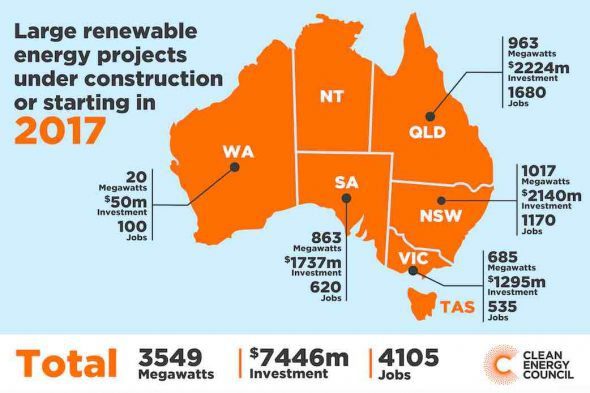Australia is experiencing its biggest ever investment spree in large-scale renewable energy, according to two new sets of data, putting the 2020 renewable energy target well within reach.
The Clean Energy Council confirmed on Wednesday that new figures put the value of large scale wind and solar projects, and one solitary biomass plant, beginning construction in 2017 at $7.5 billion.

The tally, spread evenly around the country, with the exception of Western Australia and Tasmania, represents 3,549MW, with large-scale solar overtaking large-scale wind, and will result in the creation of 4,105 jobs during the building phase.
More than $2 billion worth of these renewable energy projects have attracted financial commitment in just the last three months, boosted by a string of large-scale solar project announcements since February as solar costs challenge wind energy.
“Large-scale renewable energy, combined with the continued strong uptake of rooftop solar and emergence of energy storage, provides a clear pathway for Australia’s future energy needs,” CEC chief executive Kane Thornton said, adding that new generation was necessary to ensure energy security as coal plants such as Hazelwood retired.
The Clean Energy Regulator also released its own data, which shows that the surge in project announcement, particularly in the more quickly-constructed solar plants, means that the 2020 target is likely to be reached – and a long predicted deficit in large scale certificates in 2018 may also be averted.
The pace is so great that according to executive general manager Mark Williamson, enough projects could be committed by the end of this year to meet the 2020 target – that will be one year earlier than anticipated.
Already, 3,300MW has been committed in the last 15 months, and most of it in the last six to eight months and there was a huge pipeline ahead.
The main cause is the push to solar, which is falling in costs and can be built faster. The use of single axis tracking is also increasing its output from around 25 per cent capacity to more than 30 per cent capacity.
Compare solar & battery storage quotes for free
Image via source: Clean Energy Council
© 2017 Solar Choice Pty Ltd